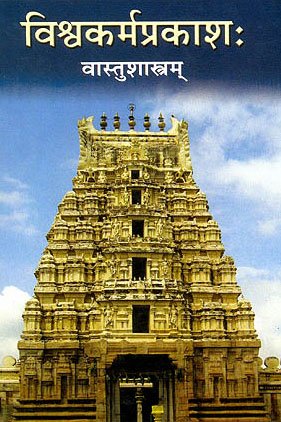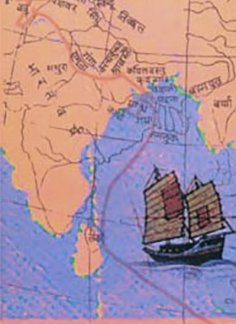Devakula, Deva-kula: 18 definitions
Introduction:
Devakula means something in Buddhism, Pali, Hinduism, Sanskrit, the history of ancient India. If you want to know the exact meaning, history, etymology or English translation of this term then check out the descriptions on this page. Add your comment or reference to a book if you want to contribute to this summary article.
In Hinduism
Vastushastra (architecture)
Source: Wisdom Library: Vāstu-śāstraDevakula (देवकुल) refers to a “temple”, and in a broader sense represents “devotional place” or “residence of God”. It is one of commonly used names for a temple, as found in Vāstuśāstra literature such the Mayamata and the Mānasāra.
Source: Shodhganga: Elements of Art and Architecture in the Trtiyakhanda of the Visnudharmottarapurana (vastu)Devakula (देवकुल) refers to the “family of heavenly trees”, according to the Viṣṇudharmottarapurāṇa, an ancient Sanskrit text which (being encyclopedic in nature) deals with a variety of cultural topics such as arts, architecture, music, grammar and astronomy.—According to the Viṣṇudharmottarapurāṇa, the door of a temple should be placed in the middle portion and the height of the door should be double of its width. The door should be made with a special kind of wood of a special kind of tree which is included in devakula i.e., family of trees of heaven or higher value. The doors should be decorated with some auspicious figures.

Vastushastra (वास्तुशास्त्र, vāstuśāstra) refers to the ancient Indian science (shastra) of architecture (vastu), dealing with topics such architecture, sculpture, town-building, fort building and various other constructions. Vastu also deals with the philosophy of the architectural relation with the cosmic universe.
Purana and Itihasa (epic history)
Source: Cologne Digital Sanskrit Dictionaries: The Purana IndexDevakula (देवकुल).—Temples where dancing girls were entertained in service.*
- * Matsya-purāṇa 70. 28.

The Purana (पुराण, purāṇas) refers to Sanskrit literature preserving ancient India’s vast cultural history, including historical legends, religious ceremonies, various arts and sciences. The eighteen mahapuranas total over 400,000 shlokas (metrical couplets) and date to at least several centuries BCE.
Kavya (poetry)
Source: ÖAW: Tantric Communities in Context (kavya)Devakula (देवकुल) refers to a “sanctuary”, according to Bāṇa’s depiction of the Caṇḍikā temple in his 7th century Kādambarī: a Sanskrit Kathā (poem) dealing revolving around the love story between prince Candrāpīḍa and the celestially beautiful princess Kādambarī.—Candrāpīḍa and his army come across the temple in the forest on their way from the Kailāsa mountain, the residence of his beloved Kādambarī, to Ujjayinī, where he was summoned to by his father Tārāpīḍa. Progressively advancing towards the inner parts of the temple area, the narrator provides a detailed description of the site and its central image of the goddess Caṇḍikā. [...] Finally, there are also cobras that live in an empty sanctuary (devakula).

Kavya (काव्य, kavya) refers to Sanskrit poetry, a popular ancient Indian tradition of literature. There have been many Sanskrit poets over the ages, hailing from ancient India and beyond. This topic includes mahakavya, or ‘epic poetry’ and natya, or ‘dramatic poetry’.
In Buddhism
Tibetan Buddhism (Vajrayana or tantric Buddhism)
Source: MDPI Books: The Ocean of HeroesDevakula (देवकुल) refers to the “clan of the Gods”, according to the 10th-century Ḍākārṇava-tantra: one of the last Tibetan Tantric scriptures belonging to the Buddhist Saṃvara tradition consisting of 51 chapters.—Accordingly: “Now, here outside, another, I shall explain the Fire Circle, [which is] red in color and is blazing greatly. He should arrange excellent Yoginīs born of the gods’ clan (devakula) and others [devādiṣu kulodbhavām] on the thirty-six spokes.—[...] The thirty-six female messengers (Yoginīs) are [thus] made known. [They are] proclaimed to be red in color, and [their physical features] such as weapons are as before. [...]”.

Tibetan Buddhism includes schools such as Nyingma, Kadampa, Kagyu and Gelug. Their primary canon of literature is divided in two broad categories: The Kangyur, which consists of Buddha’s words, and the Tengyur, which includes commentaries from various sources. Esotericism and tantra techniques (vajrayāna) are collected indepently.
India history and geography
Source: Cologne Digital Sanskrit Dictionaries: Indian Epigraphical GlossaryDevakula.—(EI 9, 23), a temple; cf. ācāryakula (LL). (EI 21), a gallery of portrait statues of deified or semi- deified ancestors. Note: devakula is defined in the “Indian epigraphical glossary” as it can be found on ancient inscriptions commonly written in Sanskrit, Prakrit or Dravidian languages.

The history of India traces the identification of countries, villages, towns and other regions of India, as well as mythology, zoology, royal dynasties, rulers, tribes, local festivities and traditions and regional languages. Ancient India enjoyed religious freedom and encourages the path of Dharma, a concept common to Buddhism, Hinduism, and Jainism.
Languages of India and abroad
Sanskrit dictionary
Source: DDSA: The practical Sanskrit-English dictionaryDevakula (देवकुल).—
1) a temple.
2) a race of gods.
3) a group of gods.
Derivable forms: devakulam (देवकुलम्).
Devakula is a Sanskrit compound consisting of the terms deva and kula (कुल).
Source: Cologne Digital Sanskrit Dictionaries: Shabda-Sagara Sanskrit-English DictionaryDevakula (देवकुल).—n.
(-laṃ) A temple. E. deva a god, and kula a house.
Source: Cologne Digital Sanskrit Dictionaries: Benfey Sanskrit-English DictionaryDevakula (देवकुल).—n. a temple, [Mṛcchakaṭikā, (ed. Stenzler.)] 30, 15. Niṣkula, i. e.
Devakula is a Sanskrit compound consisting of the terms deva and kula (कुल).
Source: Cologne Digital Sanskrit Dictionaries: Cappeller Sanskrit-English DictionaryDevakula (देवकुल).—[neuter] temple.
Source: Cologne Digital Sanskrit Dictionaries: Monier-Williams Sanskrit-English DictionaryDevakula (देवकुल):—[=deva-kula] [from deva] n. ‘deity-house’, a temple, [Śāṅkhāyana-gṛhya-sūtra; Kāvya literature; Varāha-mihira] etc.
Source: Cologne Digital Sanskrit Dictionaries: Yates Sanskrit-English DictionaryDevakula (देवकुल):—[deva-kula] (laṃ) 1. n. A temple.
Source: DDSA: Paia-sadda-mahannavo; a comprehensive Prakrit Hindi dictionary (S)Devakula (देवकुल) in the Sanskrit language is related to the Prakrit word: Deula.
[Sanskrit to German]
Sanskrit, also spelled संस्कृतम् (saṃskṛtam), is an ancient language of India commonly seen as the grandmother of the Indo-European language family (even English!). Closely allied with Prakrit and Pali, Sanskrit is more exhaustive in both grammar and terms and has the most extensive collection of literature in the world, greatly surpassing its sister-languages Greek and Latin.
Kannada-English dictionary
Source: Alar: Kannada-English corpusDēvakula (ದೇವಕುಲ):—
1) [noun] the building for the worship of a god or gods; a temple.
2) [noun] an assemblage of gods.
--- OR ---
Dēvakuḷa (ದೇವಕುಳ):—[noun] = ದೇವಕುಲ [devakula].
Kannada is a Dravidian language (as opposed to the Indo-European language family) mainly spoken in the southwestern region of India.
Pali-English dictionary
Source: Sutta: Pali Word Grammar from Pali Myanmar Dictionarydevakula (ဒေဝကုလ) [(na) (န)]—
[deva+kula]
[ဒေဝ+ကုလ]

Pali is the language of the Tipiṭaka, which is the sacred canon of Theravāda Buddhism and contains much of the Buddha’s speech. Closeley related to Sanskrit, both languages are used interchangeably between religions.
See also (Relevant definitions)
Partial matches: Deva, Kula, Teva.
Starts with: Devakula-pushkarini, Devakula-pushkariny-adhikam-karayitva, Devakulavasa.
Query error!
Full-text: Dandadevakula, Devakula-pushkarini, Devakula-pushkariny-adhikam-karayitva, Devakulika, Deula, Devakulavasa, Navadevakula, Shakyavardha, Acaryakula, Devakuta, Devalaya, Devayatana, Deva, Khanda, Door, Ambarnath, Kula, Shaiva, Caitya, Sama.
Relevant text
Search found 23 books and stories containing Devakula, Deva-kula, Dēva-kula, Dēva-kuḷa, Dēvakula, Dēvakuḷa, Devakula's, Devakulan, Devakulas; (plurals include: Devakulas, kulas, kuḷas, Dēvakulas, Dēvakuḷas, Devakula'ses, Devakulans, Devakulases). You can also click to the full overview containing English textual excerpts. Below are direct links for the most relevant articles:
Vishnudharmottara Purana (Art and Architecture) (by Bhagyashree Sarma)
8. Characteristic Features of Sarvatobhadra Temple < [Chapter 4 - Temple Building]
7. Characteristic Features of Common Temples < [Chapter 4 - Temple Building]
Pallava period (Social and Cultural History) (by S. Krishnamurthy)
Structural Temples and Sculptures (of the Pallava period) < [Chapter 2 - Origin of Sculptural Art—Its Development and Scheme]
Rock-cut architecture and sculptures < [Chapter 2 - Origin of Sculptural Art—Its Development and Scheme]
Skanda Purana (by G. V. Tagare)
Chapter 316 - Greatness of Kṣemāditya < [Section 1 - Prabhāsa-kṣetra-māhātmya]
Chapter 296 - Greatness of Ṛṣitoyā Nadī < [Section 1 - Prabhāsa-kṣetra-māhātmya]
Chapter 329 - Greatness of Unnata-Vināyaka < [Section 1 - Prabhāsa-kṣetra-māhātmya]
Chaitanya Bhagavata (by Bhumipati Dāsa)
Verse 1.17.33 < [Chapter 17 - The Lord’s Travel to Gayā]
Manasollasa (study of Arts and Sciences) (by Mahadev Narayanrao Joshi)
3. Religion during the period of Someshvara III < [Chapter 3 - Social and Political conditions reflected in Somesvara’s Manasollasa]
Architectural data in the Puranas (by Sharda Devi)
Origin of the Temple < [Chapter 3 - Temples]